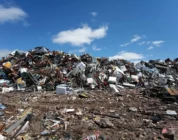Fishing nets in Karpathos, Greece. By Miemo Penttinen www.miemo.net, Creative Commons license via Flickr.
Guest Contribution, GoGreen August 16, 2017
Since humans began casting their nets out to sea, fishing gear has been abandoned in the world’s oceans, either as forgotten equipment or left as trash. It is also common for gear to get lost or torn away from fishing boats. As a result, a phenomenon called ‘ghostfishing’ has wreaked havoc throughout much of the world’s oceans. What people are unaware of is that these abandoned fishing nets and traps ensnare marine life and cause them to drown or starve to death.
‘Ghost gear’ can come in many forms, anything from floating nets, lines or pots intended to catch crab, lobster or shrimp. In more technical terms, it’s known as Abandoned, Lost, or Discarded Fishing Gear (ALDFG). Unfortunately, ALDFG is left in the sea and has the ability to capture fish, turtles, whales, sharks, rays, invertebrates, and even birds. Marine life often can’t escape and creatures live out the rest of their dying days in gear that’s recklessly left behind by humans. Hundreds of marine animals die daily from ghostfishing. According to the Northwest Straits Marine Conservation Initiative, ALDFG kill over half a million sea creatures each year in Puget Sound alone.
Harmful Effects of Ghost Gear
Nets stay afloat and move around the ocean, capturing all creatures in its path. From the weight of the catch, the net eventually sinks and shakes out some of the organisms, and then the net is light enough again to move upward. This cycle repeats itself and the net continues to trap the marine life that gets in its way. Lines and nets can also get caught on rocks, reefs or shipwrecks, which is again problematic because marine creatures can get trapped and be maimed, drown, or starve to death. Pot traps unfortunately catch more than just crab, lobster and shrimp. Many bottom dweller creatures make their way into these traps and never find a way out.
According to Earth Island, fifty or sixty years ago, nets were more commonly made out of biodegradable materials such as hemp or cotton. These materials break down more quickly than plastic-based nets that can remain in the ocean for up to 600 years. Today it is more common to find nets and fishing gear made out of synthetic, degrade-resistant materials such as nylon. ALDFG plastics are also harmful to the oceans because they break down into smaller plastic particles and are ingested by marine life. Polyurethane chemicals from ALDFG also end up leaching into the water.
The Fight Against Ghostfishing
As the fishing industry has grown throughout the centuries, more and more fishing gear has been lost, abandoned or thrown away at sea. Ghostfishing is now considered a global problem. The report ‘Abandoned, lost or otherwise discarded fishing gear‘ issued by the UN Environment Program (UNEP) and the Food and Agriculture Organization (FAO) estimated that 640,000 tons of ALDFG are spread out across the world’s oceans. This makes up about 10 percent of the global oceanic litter. But now that the problem of ghostfishing is more widely known, there are more efforts to help address it.
One of the biggest impediments to dealing with ALDFG is that most fishing takes place in international waters. Implementing international regulations is not an easy endeavor and as a result, marine ecosystems continue to suffer. But there is work being done to put a price tag on the marine creatures that die from ALDFG. The California SeaDoc Initiative has found that, in one year one abandoned net can kill about $20,000 worth of Dungeness crabs. If some folks are not convinced by the environmental impacts of ghostfishing, perhaps they’ll change their mind when they start to see how it affects the economy of the seafood industry.
There is also a push for shoreline collection facilities or programs that take old or broken nets. Instead of throwing these nets out to sea as an ‘easy way’ to get rid of them, commercial and recreational fishers can take in their old or broken nets and have them recycled or repurposed. One initiative that tries to prevent gear from being thrown overboard is the Fishing for Energy program. They provide gear removal services at various ports throughout the United States and sort the gear into recyclable and non-recyclable materials. Any material that can’t be recycled gets converted into energy by Covanta Energy. Old fishing gear is also being repurposed by Net-Works, a European company that turns ALDFG into carpet tiles.
There are also initiatives that help clean up the mess that’s already been made. Ghost Fishing is an organization that started out de-littering shipwrecks for aesthetics near the Netherlands, but soon they discovered the importance of removing abandoned fishing gear to help save the marine creatures they would find trapped in them. They’ve now created a Ghost Fishing Network to reach out to groups worldwide that are also tackling the issue of ALDFG in the seas.
At GoGreen, we are trying to raise the conscience of the community and the world about the importance of protecting our environment.


